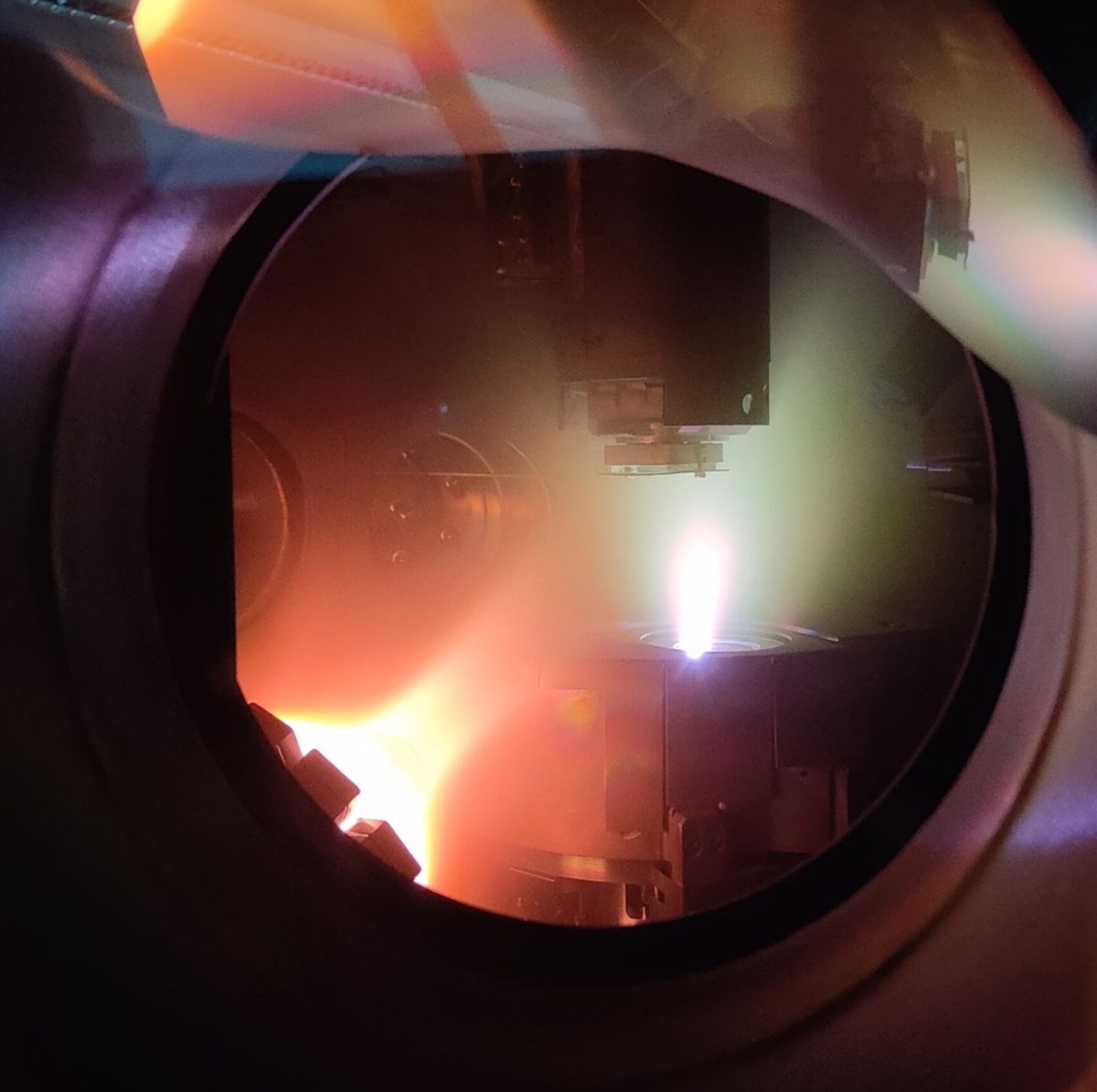Helmholtz-Zentrum Berlin's (HZB) solar fuels institute has developed a method consisting of pulsed laser deposition, coupled with flash heating and high-powered lamps, to increase the quality of thin metal oxide films for solar water splitting. The usual thermal processing process is reportedly problematic. “Reducing atomic defects concentration and improvements in crystalline order of the metal-oxide thin films would require thermal processing temperatures between 850 C and 1,000 C – but the glass substrate melts already at 550 C.” said HZB. It said that flash-heating the metal-oxide thin film through high-powered lamps could solve the problem. “This heats it up to 850 C without melting the underlying glass substrate,” HZB's solar fuels unit said on Monday. Rapid thermal processing (RTP) heating improved crystallinity, electronic properties, and performance, “leading to a new record performance of 1 mA/cm2 for this material, higher by 25% than the previous record,” it said.
The Fraunhofer Institute for Telecommunications and the Fraunhofer Heinrich-Hertz-Institut (HHI) in Germany are working on fiber-optic-based hydrogen sensors with a special functional coating around the glass fiber sensor. As the hydrogen sector grows, the focus on security is also increasing. Günter Flachenecker, senior scientist at Fraunhofer HHI, said commercially available safety sensors for hydrogen – typically catalytic heat tone sensors or electrochemical cells requiring an electrical power supply – are dangerous. “Both variants could act as a source of ignition and trigger the explosion that they are supposed to prevent, if the device or the electrical supply lines have a defect,” said Flachenecker. He added that their fixer optic sensors do not have this risk, as they do not require complex wiring. “We work with catalytic layers, for example palladium or palladium alloys. Palladium has the ability to soak up hydrogen, much like a sponge. As soon as the two substances meet, the hydrogen disintegrates into its atomic fragments and the hydrogen atoms that are released penetrate the crystal framework of the palladium. This causes elongation in the optical fiber, which can be measured instantaneously,” said Flachenecker. According to a Fraunhofer HHI press release last week, optical fibers are predestined for sensory applications in a safety-related environment, “because they are robust and have only a small diameter of around a quarter of a millimeter.”
NTU Singapore is developing new technologies to extract hydrogen from liquid organic hydrogen carriers. It has the support of the National University of Singapore (NUS). Japan’s Chiyoda Corp. and Mitsubishi Corp., Singapore’s PSA Corp., and Sembcorp Industries are also collaborating on the project, according to NTU Singapore.
The European Energy Exchange (EEX) has started working on a hydrogen index based on price assessments by market participants, in order to establish reliable marketplaces for hydrogen. EEX has also said that it is participating in the German-government-supported H2Global Foundation, joining Siemens Energy Global, Thyssenkrupp, Deutsche Bank, Salzgitter, and Uniper. “In the interest of the federal government, the German economy and, last but not least, society, we see it as our urgent task to establish a strong and internationally diversified supply chain for green hydrogen. Trading on an exchange is absolutely a part of this as an allocation and coordination mechanism,” said H2Global CEO Markus Exenberger.
Indian Oil, Larsen & Toubro (L&T), and ReNew have signed a binding term sheet to potentially form a joint venture to develop the green hydrogen sector in India. The three companies would each hold equal stakes in the proposed ventures. “Indian Oil and L&T have signed a binding term sheet to form a (venture) with equity participation to manufacture and sell electrolyzers used in the production of green hydrogen,” New Delhi-based Indian Oil said on Monday. Draft guidelines for India's National Green Hydrogen Energy Mission indicate that around 40% of the hydrogen produced in the country (around 5 MMT) will be green by 2030.
Green Energy Oman (GEO), an Oman-focused consortium, awarded a contract to Australian engineering company Worley to support its 25GW low-carbon fuels project. “Worley is providing concept feasibility study services to develop and challenge GEO's defined green hydrogen energy project. The project includes optimizing around 25GW of wind and solar generation, transforming this renewable energy through electrolysis into green hydrogen, as well as the production, storage, and export of green ammonia,” Worley said on Tuesday. The consortium includes the Sultanate of Oman’s integrated energy company OQ, InterContinental Energy, and EnerTech, a Kuwaiti government-backed clean energy investor and developer. Worley said the project aims to produce more than 1.8 million tons of low-carbon green hydrogen.
Aragon Hydrogen Valley, the Hydrogen Valley of Catalonia, the Basque Hydrogen Corridor, and the Green Hydrogen Agenda of Navarre agreed on Monday to jointly create the Ebro Hydrogen Corridor, a project that will enhance inter-territorial coordination between regional initiatives in northeastern Spain. The project is supported by regional entities and the government in Madrid. The Ebro Hydrogen corridor will target the installation of 1.5GW of renewable hydrogen production capacity, as well as annual production of 250,000 tons of renewable hydrogen products by 2030. Repsol CEO Josu Jon Imaz opened the launch event.
The European Investment Bank (EIB), Instituto de Crédito Oficial (ICO), and Iberdrola have agreed to produce green hydrogen for industrial use. “To this end, Iberdrola will receive €53 million from the EIB and €35 million from ICO,” said the EIB on Monday.
Uruguay's Ministry of Industry, Energy and Mining (MIEM), the Technological Laboratory of Uruguay, and the National Agency for Research and Innovation have launched the Green Hydrogen Sectoral Fund, which aims to finance research, innovation, and training projects. National legal entities, private sector groups, and companies with a proven track record with electrolyzers of at least 1 MW in size can potentially benefit from the fund.
Suncor said it plans to divest its wind and solar assets while strengthening its focus on hydrogen and renewable fuels. The Calgary-based energy company has also announced plans to partner with ATCO on a project to build a world-scale hydrogen project in the Canadian province of Alberta and deploy renewable fuel technologies. “By doing so, we use our strengths, competitive advantages and resources,” Mark Little, Suncor chief executive officer, said on Monday.
ZeroAvia and ZEV Station have signed a deal to develop green hydrogen refueling infrastructure for airports in California. Several publications have also reported that Hyundai might step up its hydrogen fuel cell aircraft plans, with a focus on longer-range eSTOL aircraft.
Hyundai Motor Group, Saudi Arabian Oil Company (Aramco) and King Abdullah University of Science and Technology (KAUST) have agreed to jointly develop an advanced fuel for an ultra lean-burn, spark-ignition engine, with the aim of lowering the overall carbon dioxide emissions of vehicles. “BEVs and FCEVs will be Hyundai Motor Group’s ultimate technologies to achieve carbon neutral mobility,” Alain Raposo, executive vice president of Hyundai Motor Group, said last week.
Nel Hydrogen – which will open its new hydrogen factory in Herøya, Norway, on April 20 – has received two new purchase orders. Biproraf ordered one hydrogen fueling station for fuel cell vehicles and forklifts in Poland. And Hydrogen Technology and Energy Corp. has ordered a hydrogen-fueling module for zero-emission light vehicles in the Canadian province of British Columbia. The latter order is in line with British Columbia's efforts to open an office to expand hydrogen deployment, with the aim of streamlining projects from proposal to construction. “The BC Hydrogen Office will work with federal and local governments to help attract investments and simplify the multi-jurisdictional review and permitting processes,” the provincial government said last week.
This content is protected by copyright and may not be reused. If you want to cooperate with us and would like to reuse some of our content, please contact: editors@pv-magazine.com.


8 comments
By submitting this form you agree to pv magazine using your data for the purposes of publishing your comment.
Your personal data will only be disclosed or otherwise transmitted to third parties for the purposes of spam filtering or if this is necessary for technical maintenance of the website. Any other transfer to third parties will not take place unless this is justified on the basis of applicable data protection regulations or if pv magazine is legally obliged to do so.
You may revoke this consent at any time with effect for the future, in which case your personal data will be deleted immediately. Otherwise, your data will be deleted if pv magazine has processed your request or the purpose of data storage is fulfilled.
Further information on data privacy can be found in our Data Protection Policy.